The young woodland on the slope at the north end was the first restoration effort of the Task Force to Bring Back The Don (TFBBD). This is one of six projects in Riverdale Park (East and West) that this group has had a hand in. Here an area of mown grass, typical of a city park, was planted with trees and shrubs in 1990 and is now a young woodland of Silver and Sugar Maples and Ash; plus Sumac, White Cedar and White Pine. Manitoba Maple and Ailanthus have seeded in places. Herbs and shrubs were added later.
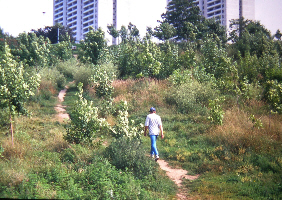
Riverdale Woodland August 1996
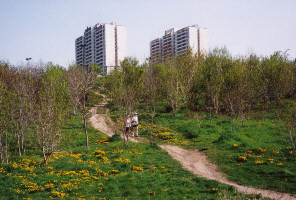
Riverdale Woodland May 2000
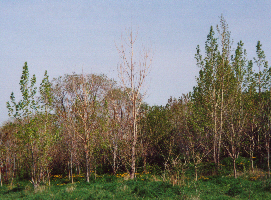
Riverdale Woodland May 2000
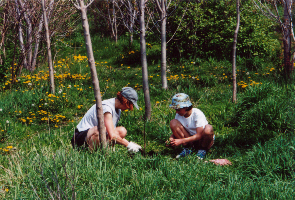
Planting herbs and shrubs in May 2000
The TFBBD got world wide publicity when Charles, Prince of Wales, visited this area in 1991.
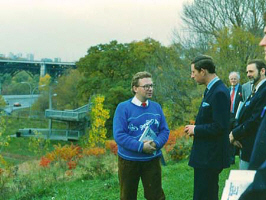
Mark Wilson, then Chair of TFBBD, shows newly planted woodland to Prince Charles.
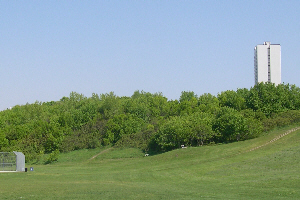
Woodland May 2007
West Riverdale Woodland: A similar though smaller woodland is located in West Riverdale Park south of the Riverdale Farm.
East Riverdale Wetland: More recently. a small wetland was established at the foot of the wooded north slope with the help of The Toronto and Region Conservation Authority.
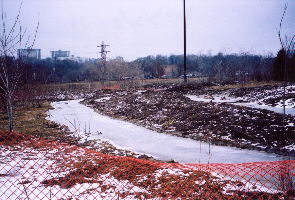
Wetland under construction March 2002
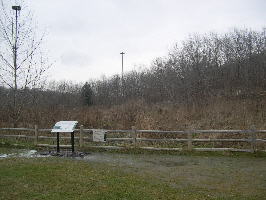
Wetland December 2006
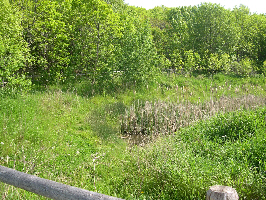
Wetland May 2007
Water was collecting at the base of the slope, flowing from both the steep slope to the north and the gentle slope from the sports field to the south. This project turned, what had been a soggy frequently unusable open space, into a new natural area. Machines were used to form the ponds and berms, then an eroded hillside path was made into a rock lined channel directing water into the wetland. Finally volunteers planted trees, shrubs and marsh plants, including native flowers, sedges, and rushes. One can see the new wetland behind the cedar rail fence.
Riverdale Farm Ponds: The Sanctuary and Lower Ponds at the Riverdale Farm are the remains of a river oxbow. Before the Don River was straightened and channelled in the late 19th century, the Don flowed through the area now occupied by these ponds. During the time of the Riverdale Zoo these were used by the Hippopotamuses. In the mid 1990s, the hard concrete and stone shorelines of these ponds were eliminated to create a natural shoreline. Then hundreds of volunteers from schools and the local community planted nearly 2000 trees and shrubs and 3000 wildflowers and wetland plants. This was a co- operative project involving Toronto and Region Conservation Authority (TRCA), the City of Toronto, Parks and Recreation and the TFBBD that has created valuable wetland habitat for local and migratory wildlife and also an opportunity for the public to learn about wetlands.
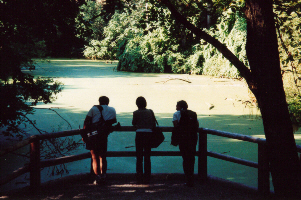
Sanctuary Pond viewing platform
Viewing platforms allow visitors to get close to the water and pond life without trampling the vegetation. Vegetation around the Lower Pond is dense with maturing native tree and shrub species we are told by a recent report. The edge of the pond is primarily a mixture of native aquatic vegetation, such as Cattails, Arrowheads and sedges, and non-native European Water Horehound. Unfortunately, the Sanctuary Pond and the ravine slope adjacent to the Lower Pond are dominated by non-native invasive species, which are seeding into the Lower Pond area. Areas with dry soil are densely covered by saplings and shrubs. Many trees and shrubs that have been planted or grown naturally have been very successful around the Lower Pond: Elderberry, Red Osier Dogwood, Speckled Alder, Swamp Rose, Eastern Cottonwood, Green Ash, and several native willows. Tree species list in 2002 included: Austrian pine, Black Locust, Eastern Cottonwood, Crack Willow, Eastern White-Cedar, Green Ash, Manitoba Maple, Osage Orange, Scotch Elm, Siberian Elm, Silver Maple, Tree of Heaven, Weeping Willow, White Elm and White Mulberry.
East Riverdale Wet Meadow: Native wetland plants were encouraged in an area of wet ground fed by springs, on the east slope of Riverdale Park East.
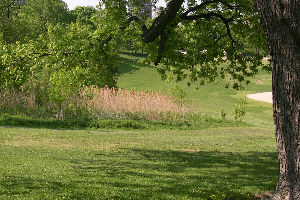
Riverdale Wet Meadow, May 2007.
East Riverdale Buffer Zone: Trees and shrubs were also planted along the fence next to the DVP as a windbreak.
Lower Don Trail: The narrow strip of land between the Lower Don Trail and the channel has been The site of several TFBBD tree and shrub plantings and stewardship activities. The latter included the removal of invasive exotics such as Ailanthus in order to make room for valuable native trees.
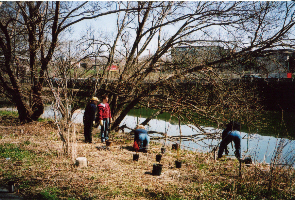
Planting along the Lower Don Trail April 2003
For more about The Task Force to Bring Back The Don and its projects see Bring Back The Don
